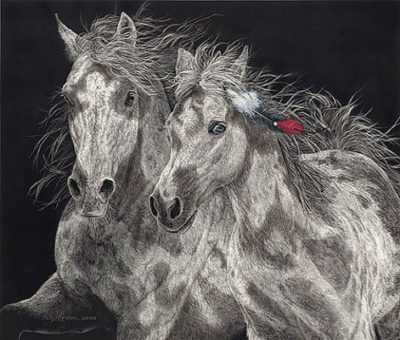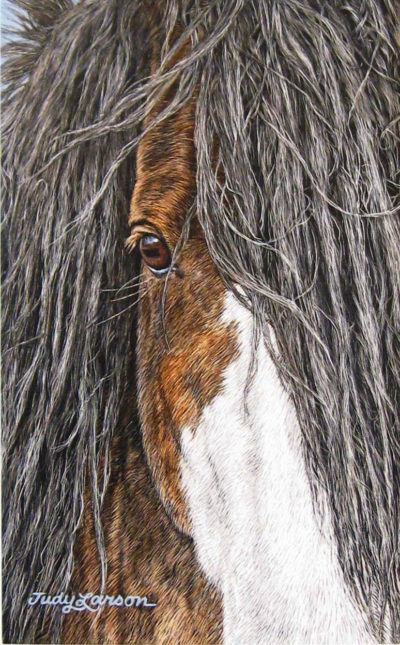A Time to Heal
Artwork Description
The old, traditional ways of wolfing had seriously reduced wolf populations, even more barbaric forms of annihilating wolves were instituted.
The “loop” refers not to a device designed to ensnare adult wolves but to trap and hand up living pups while the adult pack was away from the den in the nighttime hunt. Made of wire and spring-loaded hooks, the long trap offered tempting bits of meat to the unsuspecting pups. As they were caught, the strangling youngsters struggled and cried out in pain and panic, but their mother could do nothing but lick them and try to comfort them. When the pack members returned a dawn, each was gunned down until all the adults had been killed. Only then did the wolfer step in to kill the pups as well, effectively wiping out an entire family.
An ancient Indian story says that the spirits of all the slaughtered wolves of this vast land have gathered at a distant mountaintop, awaiting the time when they can safely return to roam the land they love. For much of our country this time has not come, but hope remains that what has happened over the last few years on the tribal lands of the Nez Perce can one day occur throughout our great land.
The Nez Perce have long been admired for their skill in horsemanship and their ability to breed exception horses, known today as Appaloosas. These spotted horses were not only born with good “medicine” that would keep their owners safe in battle, but they were also sure-footed, strong, healthy and easy to train. In 1805, as Meriwether Lewis and William Clark passed through the Nez Perce territory, the beauty and uniqueness of the spotted horses amazed them.
In an effort to destroy the spirit of the Nez Perce, the government had hit upon one of the most potent means possible: the killing of the People’s beloved horses. By 1900, fewer than three hundred Appaloosa horses remained in the United States. For the Nez Perce, the Appaloosa and the wolf, the government’s penchant for control of people and nature came close to forcing their extinction.
But a few years ago, the Nez Perce ushered in a time of healing —one which offers potential for changing our ideas and ourselves — by welcoming to its tribal lands in Winchester, Idaho, a pack of wolves raised in captivity, formerly known as “The Sawtooth Pack.” The famous pack, first introduced to the public in the documentary “Wolves at Our Door,” is at home again on the land that its ancestors once shared with the native people. This time, however, the eleven “Wolves of the Nez Perce” play different roles: as ambassadors for their wild brothers and sisters. The mission of the accompanying Wolf Education and Research Center is to promote awareness of wolves and to learn through education for the purpose of co-existing with them. Visitors are provided with a rare opportunity to experience the wonder of wolves in a natural setting and to partner in this mission with the Nez Perce, a native people rich in culture, history and ecological understanding.
Now, more than ever, it is a time to heal.









